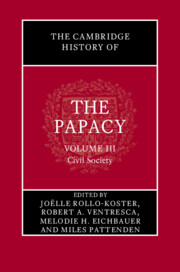1145 results
6 - Environmental Outcomes
- from Part II - What Difference Does It Make? Consequences of Corruption
-
- Book:
- Corruption in America
- Published online:
- 21 March 2025
- Print publication:
- 03 April 2025, pp 97-109
-
- Chapter
- Export citation

Corruption in America
- A Fifty-Ring Circus
-
- Published online:
- 21 March 2025
- Print publication:
- 03 April 2025
From autism to the plural ‘autisms’: evidence from differing aetiologies, developmental trajectories and symptom intensity combinations
-
- Journal:
- The British Journal of Psychiatry , FirstView
- Published online by Cambridge University Press:
- 21 March 2025, pp. 1-7
-
- Article
- Export citation
19 - Care for Our Common Home: The Papacy and the Environment
- from Part III - Science, Medicine, Technology
-
-
- Book:
- The Cambridge History of the Papacy
- Published online:
- 28 February 2025
- Print publication:
- 20 March 2025, pp 536-572
-
- Chapter
- Export citation
HIDING IN PLAIN SIGHT Why we missed the threat of a new pandemic – and other existential risks
-
- Journal:
- Asia-Pacific Journal / Volume 19 / Issue 14 / July 2021
- Published online by Cambridge University Press:
- 14 March 2025, e2
-
- Article
- Export citation
The Evolution of the East Asian Eco-Developmental State
-
- Journal:
- Asia-Pacific Journal / Volume 19 / Issue 6 / March 2021
- Published online by Cambridge University Press:
- 14 March 2025, e1
-
- Article
- Export citation
Towards an Asia-Pacific ‘Depopulation Dividend’ in the 21st Century Regional Growth and Shrinkage in Japan and New Zealand
-
- Journal:
- Asia-Pacific Journal / Volume 15 / Issue 6 / March 2017
- Published online by Cambridge University Press:
- 14 March 2025, e5
-
- Article
- Export citation
4 - Environment-Induced Decoherence
- from Part II - Decoherence
-
- Book:
- Decoherence and Quantum Darwinism
- Published online:
- 06 March 2025
- Print publication:
- 13 March 2025, pp 77-108
-
- Chapter
- Export citation
Chapter 8 - Adjustments
-
- Book:
- Autistics in Academia
- Published online:
- 06 March 2025
- Print publication:
- 13 March 2025, pp 110-125
-
- Chapter
- Export citation
Chapter 5 - Challenges
-
- Book:
- Autistics in Academia
- Published online:
- 06 March 2025
- Print publication:
- 13 March 2025, pp 59-79
-
- Chapter
- Export citation

The Cambridge History of the Papacy
-
- Published online:
- 28 February 2025
- Print publication:
- 20 March 2025
Promoting Physical (Ecological) Literacy through Physical Education: Everyone’s Response-ability in a World Gasping for Air
-
- Journal:
- Australian Journal of Environmental Education , First View
- Published online by Cambridge University Press:
- 13 February 2025, pp. 1-17
-
- Article
-
- You have access
- Open access
- HTML
- Export citation
4 - The Role of National and Regional Institutions in Biodiversity and Forest Conservation
- from Part I - Introductory Context and Principles
-
-
- Book:
- Biodiversity and Nature Conservation Law and Policy in the Middle East and North Africa Region
- Published online:
- 06 February 2025
- Print publication:
- 13 February 2025, pp 65-86
-
- Chapter
-
- You have access
- Open access
- HTML
- Export citation
Conversation 1 - Why Innovate?
-
- Book:
- Legal Innovation
- Published online:
- 06 February 2025
- Print publication:
- 13 February 2025, pp 1-31
-
- Chapter
-
- You have access
- Open access
- HTML
- Export citation
Mapping the exposome of mental health: exposome-wide association study of mental health outcomes among UK Biobank participants
-
- Journal:
- Psychological Medicine / Volume 55 / 2025
- Published online by Cambridge University Press:
- 07 February 2025, e16
-
- Article
-
- You have access
- Open access
- HTML
- Export citation
7 - The UN General Assembly and Peaceful Change
- from Part III - Practice
-
-
- Book:
- International Organizations and Peaceful Change in World Politics
- Published online:
- 30 January 2025
- Print publication:
- 06 February 2025, pp 153-180
-
- Chapter
- Export citation
Chapter 13 - A ‘sweet especial rural scene’? Nature, Culture, and Agriculture in the 1870s
-
-
- Book:
- Nineteenth-Century Literature in Transition: The 1870s
- Published online:
- 30 January 2025
- Print publication:
- 06 February 2025, pp 274-294
-
- Chapter
- Export citation

Institutions and Environment in Ancient Southern East Asia (3000 BCE to 300 CE)
-
- Published online:
- 01 February 2025
- Print publication:
- 30 January 2025
-
- Element
-
- You have access
- Open access
- HTML
- Export citation
3 - An Imperial Economy and the Great Transformation
- from I - 1750–1819: The Ends of the Ancien Régime
-
- Book:
- Modern Britain, 1750 to the Present
- Published online:
- 14 January 2025
- Print publication:
- 30 January 2025, pp 75-110
-
- Chapter
- Export citation
1 - Caravans Exposed
-
- Book:
- The Last Caravan
- Published online:
- 09 January 2025
- Print publication:
- 23 January 2025, pp 39-72
-
- Chapter
- Export citation


